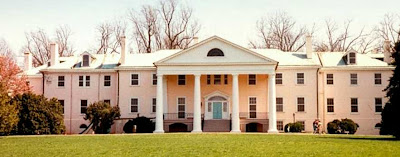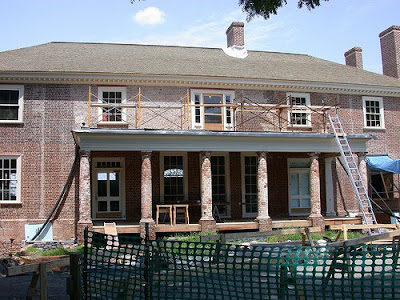Montpelier, the Virginia home of James and Dolley Madison, has been returned to its circa 1825 appearance, following a five year $24 million restoration. The completion of the project was celebrated on September 17, 2008, Constitution Day. James Madison, our fourth president (1809-1817) was known as the Father of the Constitution, since he was the principal author of the document. The most astonishing thing about the restoration of this house is that it was hiding in plain sight for over a hundred years, sitting behind and beneath enormous additions and alterations, which have been removed.
Montpelier was built around 1760 by Madison’s father, enlarged in 1797 after Madison retired from Congress, and expanded again in 1809 immediately after his election as president of the United States. After Madison’s death, his widow, Dolley, kept Montpelier until 1844. The property bounced from owner to owner until it was bought by William duPont in 1901.
 Montpelier as it appeared in 1993.
Montpelier as it appeared in 1993.The duPont family added 33 rooms (20,000 sq. ft) to the extant 22-room mansion (13,000 sq. ft. at the time of Madison's death), raising the height of the wings on either side, for a cozy total of 33,000 sq. ft. Amazingly, they did not demolish any of the president's original home but covered it up with layers of additions and alterations. The original brick was masked by a fleshy pink stucco that unified the old and new structures. A few interior photographs taken prior to 1901 allowed preservationists to return the mansion to its early 19th century floor plan and appearance.

 Photo above: rear of house in 2002
Photo above: rear of house in 2002Photo below: 2007. The vertical line on the bricks clearly shows where the rear duPont wings were removed.

When Marion duPont Scott, William’s daughter, died in 1983, she bequeathed the house to the National Trust for Historic Preservation, dictating that it be restored to its condition when James and Dolley Madison lived there in the years immediately following his presidency.
Her Art-Deco "trophy room" that paid homage to her equestrian interests was dismantled and reinstalled in the visitor center, so that a bit of the duPont legacy can be enjoyed by today's visitors.

Mustard Seed Master Builders helped to set the historical record straight by bringing Montpelier’s original 12,000-sq.-ft. form back from 160 years of remodeling and decay. Proprietor Scott McBride has taken part in some important historic restorations, but nothing quite like this. As McBride explains: “When I initially met with Mark Wenger (the project’s architectural historian), he said to me, ‘This is the most important house you or I will ever work on.’ And so it was.” Adding to the complexity of the restoration was the fact that the house remained open to visitors throughout remodeling, and any and all original material that was in usable condition had to be incorporated into the project. The photo below shoes the drawing room during restoration:

A recent photo shows the same room after reproduction wallpaper and draperies were installed:
Part of the original house, these arches (shown in the photo below) were removed during remodeling in the 20th century. The duPont family saved and labeled each piece for future re-use, knowing that they were altering a historic residence.

Montpelier (Orange, Va.)
9:30-5:30 pm daily Apr-Oct; until 4:30 Nov-Mar
$14 entry fee.
http://www.montpelier.org
540.672.2728
 Take Rt. 15 south from Culpeper. At Orange, take a right at the second stoplight onto Route 20 south. Go 4 miles to the Montpelier entrance on the left.
Take Rt. 15 south from Culpeper. At Orange, take a right at the second stoplight onto Route 20 south. Go 4 miles to the Montpelier entrance on the left. The four portico columns, crafted of brick, are shown here during restoration with a coating of stucco, which was later painted white to give the appearance of painted wood. Compare to the photo at top of post, showing original color green shutters reinstalled.
The four portico columns, crafted of brick, are shown here during restoration with a coating of stucco, which was later painted white to give the appearance of painted wood. Compare to the photo at top of post, showing original color green shutters reinstalled.








